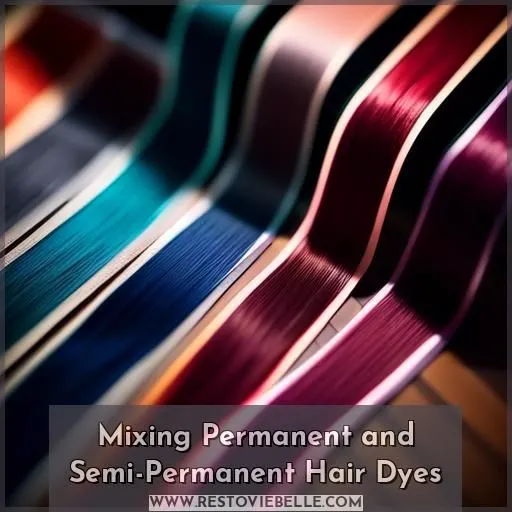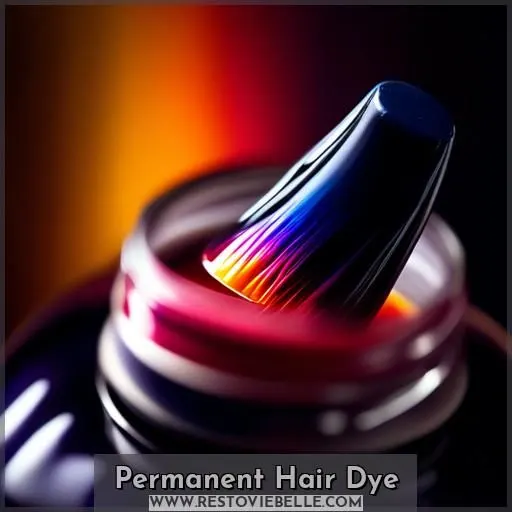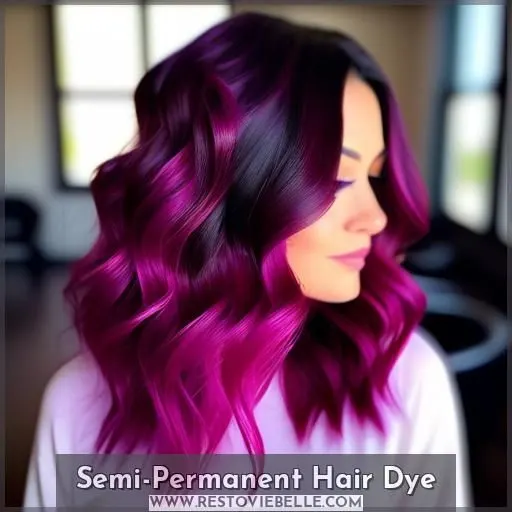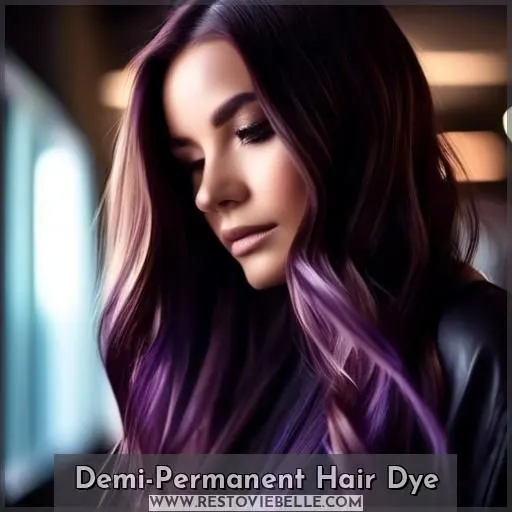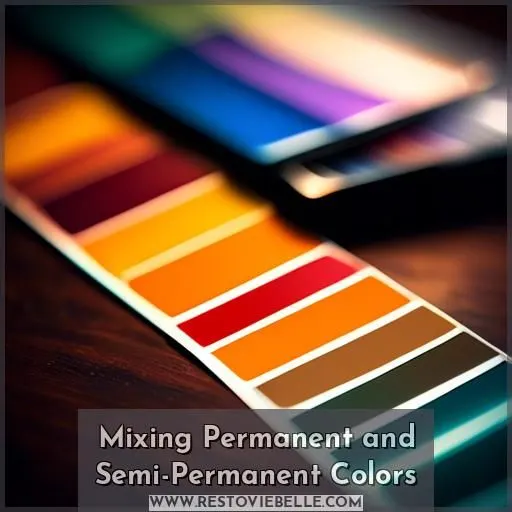This site is supported by our readers. We may earn a commission, at no cost to you, if you purchase through links.
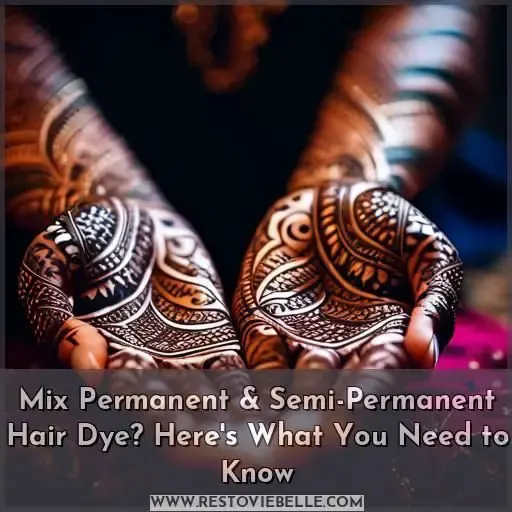
You can combine permanent and semi-permanent hair dyes, but you’ll need to take some precautions. Permanent hair dye contains ammonia and peroxide to penetrate the hair shaft and produce long-lasting results, while semi-permanent dyes use larger molecules that only deposit on the surface.
Mixing these two can dilute the color, create a wispy or translucent appearance, and even produce unexpected shades. To make sure compatibility, communicate the risks and benefits to your clients, follow the manufacturer’s mixing instructions, and wear gloves. Doing so can help you achieve the desired color results.
Table Of Contents
- Key Takeaways
- Can You Mix Permanent and Semi Permanent?
- Mixing Permanent and Semi-Permanent Hair Dyes
- Permanent Hair Dye
- Semi-Permanent Hair Dye
- Demi-Permanent Hair Dye
- Mixing Permanent and Semi-Permanent Colors
- Frequently Asked Questions (FAQs)
- Can mixing permanent and semi-permanent hair dyes cause hair damage?
- What are the risks of mixing different brands of hair dyes?
- Is it possible to mix permanent and semi-permanent hair dyes to create a demi-permanent color?
- How does the mixing of permanent and semi-permanent hair dyes affect the color outcome?
- What are the safety precautions when mixing hair dyes?
- Conclusion
Key Takeaways
- Mixing permanent and semi-permanent hair dyes can lead to unpredictable results, including diluted color, unexpected shades, and a wispy or translucent appearance.
- To achieve the desired color results, communicate risks and benefits to clients, follow manufacturer instructions, and wear gloves.
- Permanent hair dye contains ammonia and peroxide, while semi-permanent dye does not, which affects their compatibility and potential for hair damage.
- Demi-permanent hair dye is a good option for those who want a longer-lasting color change than semi-permanent but aren’t ready for a permanent commitment. It contains some peroxide to develop the hair, providing conditioning benefits and is suitable for all hair types.
Can You Mix Permanent and Semi Permanent?
No, you can’t mix permanent and semi-permanent hair dyes together. Doing so can lead to unpredictable results and potentially damage your hair.
Mixing Permanent and Semi-Permanent Hair Dyes
Mixing permanent and semi-permanent hair dyes can lead to unpredictable results. Permanent hair color contains ammonia and peroxide, while semi-permanent hair color does not. Mixing different brands of hair dye can also increase the risk of hair damage.
Mixing permanent and semi-permanent colors can create unexpected shades, and mixing different colors of hair dye can result in a translucent, wispy appearance.
It’s recommended to always follow the manufacturer’s instructions when using hair dye and to wear gloves and avoid getting hair dye in your eyes.
Permanent Hair Dye
After exploring the intricacies of combining hair dyes, let’s venture into the domain of permanent hair dye. This isn’t merely about altering hues; it’s about comprehending the color spectrum and preserving the well-being of your hair.
-
Color Endurance: Permanent hair dye grants a lasting metamorphosis, making it the preferred choice for those desiring a substantial alteration without incessant retouches.
-
Porous Hair Compatibility: It’s a delicate interaction with porous hair, as the potent components can be both a boon and a bane.
-
Ammonia Substitutes & Home Safety: Understanding the range of ammonia alternatives and developer choices is essential for preventing hair damage, ensuring you avoid a perilous gamble with your tresses.
Semi-Permanent Hair Dye
Semi-permanent hair dye offers a revitalizing and temporary tint that can enhance the natural hue of your hair without causing significant damage. Here are three key points about semi-permanent hair dye:
- Fading: Semi-permanent hair dye fades more quickly than permanent hair dye, typically lasting up to 8 shampoos.
- Color Refresh: It’s suitable for those who want to add luster and refresh their tone without altering the hair color permanently.
- Tone Enhancement: Semi-permanent hair dye blends with natural hair color, providing translucent coverage.
Semi-permanent hair dye contains larger molecules than permanent hair dye, allowing it to be applied to dry hair and providing a more subtle color change. It’s also suitable for porous hair, making it an excellent option for those with damaged or fragile hair.
When using semi-permanent hair dye, it’s essential to follow the manufacturer’s instructions and wear gloves to avoid skin irritation. It’s also recommended to test the dye on a small area of skin before applying it to your hair.
If you’re looking for a more vibrant or long-lasting color, you may consider using permanent hair dye, which uses ammonia and peroxide to penetrate the hair shaft and provide full coverage with gradual fade. However, permanent hair dye can be more damaging to your hair and may require more frequent touch-ups to maintain the color.
Demi-Permanent Hair Dye
Demi-permanent hair dye is a great choice for those who want a longer-lasting hair change than semi-permanent hair dye but aren’t ready for a permanent commitment. It’s perfect for going darker or covering grays, while semi-permanent hair dye is better for minimal grays or those just wanting a color boost. Here are four key points about demi-permanent hair dye:
- Application: Demi-permanent hair dye contains some peroxide to develop the hair, which opens the hair cuticle slightly, allowing the dye to penetrate the hair, resulting in a more dramatic change and longer-lasting color.
- Benefits: This type of hair dye provides conditioning benefits, making it ideal for those who want to change up their hair color but don’t want to deal with potential damage or the growing out of permanent dye.
- Maintenance: To maintain the color, use a moisturizing shampoo and conditioner, keep hair out of the sun’s harsh rays, and wash hair less frequently to keep the color locked in for as long as possible.
- Versatility: Demi-permanent hair dye is suitable for all hair types, including porous hair, and can be used to create a wide range of shades.
Demi-permanent hair dye is a great option for those who want a more dramatic change than semi-permanent dye but don’t want the commitment of permanent dye. It’s also ideal for those who want to cover grays or enhance their natural hair color without damaging their hair.
Mixing Permanent and Semi-Permanent Colors
Mixing permanent and semi-permanent hair dyes can lead to unexpected results, and it’s essential to follow the specific instructions for each type of dye to achieve the desired outcome. Here are some key points to keep in mind when mixing these two types of hair dyes:
- Color Dilution: Mixing permanent and semi-permanent hair dyes can dilute the color, resulting in a translucent, wispy appearance.
- Tone Compatibility: Make sure that the colors are compatible before mixing. Mixing different shades can create unexpected tones.
- Porosity Considerations: Porosity plays a significant role in how dyes interact with hair. Mixing dyes with different porosity levels can affect the final color outcome.
- Client Expectations: Communicate with your clients about the potential risks and benefits of mixing permanent and semi-permanent hair dyes, as well as the expected results.
If you decide to mix permanent and semi-permanent hair dyes, follow these steps:
- Equal Parts: Mix equal parts of each dye.
- Developer: Use a low-volume developer to help open the cuticle and ensure even color distribution.
- Application: Apply the mixture to clean, dry hair, starting from the roots and working your way down to the ends.
- Processing Time: Leave the color on for the recommended time (usually 20-30 minutes).
- Rinse and Condition: Rinse out the color and follow up with a conditioner or hair mask.
Frequently Asked Questions (FAQs)
Can mixing permanent and semi-permanent hair dyes cause hair damage?
Combining clashing colors can cause colossal chaos, compromising your crowning glory. Cautiously consider color compatibility to circumvent costly calamities and cultivate alluring, healthy-looking hues that harmonize seamlessly.
What are the risks of mixing different brands of hair dyes?
Mixing different hair dye brands can spell disaster – unpredictable color results, patchy coverage, and even hair damage. It’s a risky game best avoided. Stick to one brand for seamless, healthy color.
Is it possible to mix permanent and semi-permanent hair dyes to create a demi-permanent color?
You can mix permanent and semi-permanent hair dyes to create a demi-permanent color, but the results may be unpredictable and lead to unintended tones or fading. It’s best to consult a professional colorist for the desired outcome.
How does the mixing of permanent and semi-permanent hair dyes affect the color outcome?
Mixing permanent and semi-permanent dyes can create an unpredictable, translucent color result. The permanent molecules may overwhelm the larger semi-permanent ones, leading to patchy, washed-out hues. It’s best to stick to one color type for reliable results.
What are the safety precautions when mixing hair dyes?
Woah there, partner! When mixing hair dyes, always follow the manufacturer’s instructions to a tee. Wear gloves, avoid getting it in your eyes, and do a patch test before applying to your whole head. Mixing different brands? That’s a recipe for disaster, my friend.
Conclusion
Blending permanent and semi-permanent hair dyes can be a delicate dance, but with the right steps, you can create a masterpiece. Communication with your clients, following manufacturer instructions, and wearing gloves are essential to successfully mixing these dyes.
Whether you’re aiming for a vibrant hue or a subtle shift, learning to mix permanent and semi-permanent colors can expand your artistic palette and deliver the desired results your clients crave.

